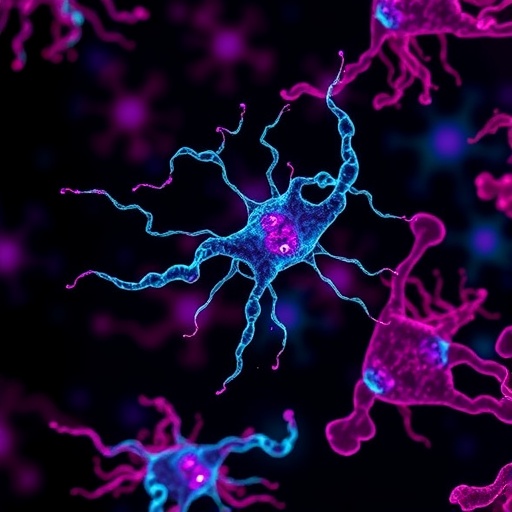
In the realm of neuroscience, new frontiers are constantly being explored, especially in the treatment of traumatic brain injury (TBI). Recent research led by Liu, Gong, and Zhang has generated significant interest, focusing on the effects of esketamine in alleviating the consequences of TBI. This innovative study, published in BMC Neuroscience, shines a light on the underlying biological mechanisms, particularly the modulation of STAT3-mediated glycolysis and immune responses, clarifying how esketamine can potentially reshape therapeutic strategies for TBI.
Esketamine, a derivative of ketamine, is gaining traction in clinical settings for its rapid antidepressant effects. However, its neuroprotective properties, especially concerning brain injury, are being probed for deeper insights. The research team aimed to establish a clear connection between esketamine administration and the modulation of critical metabolic and immunological pathways involved in the aftermath of TBI. Their findings suggest that beyond its antidepressant effects, esketamine may serve as a robust neuroprotective agent.
The starting point of their investigation centered around cytokine signaling. Specifically, the activation of the signal transducer and activator of transcription 3 (STAT3) pathway is pivotal in cellular responses to injury. In TBI, dysregulation of cytokine production often leads to amplified inflammation which exacerbates the damage. By influencing this pathway, esketamine appears to provide a dual benefit of mediating inflammatory responses while also sustaining cellular metabolism, particularly glycolysis, which is essential for neuronal survival during stress conditions.
Moreover, this study delves into the duality of esketamine’s effects on inflammation and metabolism. The authors elucidate how ischemic conditions often create a tension between cellular energy demands and the metabolic supply. In their experiments, esketamine was shown to attenuate oxidative stress and prevent cell death, thus ensuring that neurons maintain adequate energy levels. Enhanced glycolysis, driven by STAT3 activation, can promote survival pathways, indicating a novel avenue for therapeutic intervention that could dramatically improve patient outcomes following TBI.
Interestingly, immune responses are seen as both a defender and a potential aggressor in cases of brain injury. Liu and his collaborators mapped out the interplay between neuroinflammation and cellular metabolism, leading to a better understanding of how esketamine could recalibrate these processes. By moderating the immune response, esketamine may not only mitigate damage directly associated with TBI but also create a neuroprotective environment suitable for healing.
The study also employed advanced experimental designs, ranging from in vivo models of TBI to cell culture systems, laying a robust foundation for their conclusions. The integration of diverse methodologies reinforces the validity of their findings, demonstrating that the therapeutic effects of esketamine are not occurrences limited to a singular experimental paradigm. The translational potential of these outcomes could reshape clinical approaches to managing TBI in hospitals globally.
Furthermore, the research invokes a broader conversation about the implications of modulating critical biological pathways for therapeutic purposes. There exists a growing recognition that existing therapeutic strategies may not fully address the multifaceted challenges of TBI. Precisely targeting metabolic pathways could pave the way for treatments that not only stabilize patients post-injury but also enhance long-term recovery trajectories, which has long been the Holy Grail in TBI management.
Although these early findings are promising, the research team acknowledges that further studies are required to deepen the understanding of the dose-response nature of esketamine’s effects. Future investigations will be vital to delineate the pharmacological profiles that separate therapeutic benefits from potential side effects. As interest in this compound grows, the scientific community will need to fine-tune dosage strategies to maximize neuroprotective benefits while minimizing adverse outcomes.
As the research progresses, regulatory pathways for the introduction of esketamine in mainstream TBI management are likely to emerge. The study’s implications not only highlight a novel use of an existing drug but also inspire the pharmaceutical industry to explore existing compounds for innovative applications in neurology. Such repositioning offers a quicker path to clinical use, shifting from traditional drug development timelines that can span years or decades.
Moreover, bridging the gap between basic science and clinical application enhances our understanding of how therapeutics can be personalized for individual patients. Esketamine’s neuroprotective mechanisms may vary among different genotypes or metabolic states, warranting a tailored approach to treatment. Consequently, ongoing studies should also focus on patient selection criteria, considering factors such as pre-existing conditions, genetic predispositions, and previous trauma history to increase the potential efficacy of esketamine in TBI treatment.
In conclusion, Liu, Gong, Zhang, and their team’s exploration into the role of esketamine in traumatic brain injury marks a significant step forward in neuroscience. By elucidating the connections between immune response modulation, glycolysis management, and neuroprotection, this research not only broadens the scope of esketamine’s therapeutic potential but also signifies a paradigm shift in how we approach the catastrophic impacts of brain injuries. As they continue to unravel these complexities, the hope is to usher in a new era of treatment strategies that afford greater recovery chances for TBI patients, bringing them one step closer to regaining their quality of life.
The fusion of cutting-edge research with clinical application resonates throughout the findings, offering renewed optimism in the fight against brain injuries. Armed with a greater understanding of esketamine’s multifaceted role, healthcare providers could soon have a revolutionary tool at their disposal, transforming lives with improved therapeutics for the frequently devastating outcomes of traumatic brain injuries.
With ongoing studies and a commitment to refining these approaches, the landscape of TBI treatment is on the brink of transformation. It is an exciting time for researchers and medical professionals alike as they anticipate the tangible benefits that lie ahead. With each advancement, we must remain hopeful that science continues to yield new revelations that can profoundly impact patient care and outcomes.
Subject of Research: Esketamine and its effects on traumatic brain injury, focusing on STAT3-mediated glycolysis and immune responses.
Article Title: Esketamine attenuates traumatic brain injury by modulating STAT3-mediated Glycolysis and immune responses.
Article References:
Liu, Y., Gong, Z., Zhang, L. et al. Esketamine attenuates traumatic brain injury by modulating STAT3-mediated Glycolysis and immune responses.
BMC Neurosci 26, 21 (2025). https://doi.org/10.1186/s12868-025-00941-z
Image Credits: AI Generated
DOI: 10.1186/s12868-025-00941-z
Keywords: Esketamine, Traumatic Brain Injury, STAT3, Glycolysis, Immune Responses, Neuroprotection
Tags: BMC Neuroscience research findingscytokine signaling in neural injuryEsketamine and traumatic brain injuryesketamine as a neuroprotective agentesketamine’s effects on immune responsesglycolysis modulation in TBIinflammation and brain injury recoverymetabolic pathways in TBI treatmentneuroprotective properties of esketaminerapid antidepressant effects of esketamineSTAT3 signaling in brain injurytherapeutic strategies for traumatic brain injury




